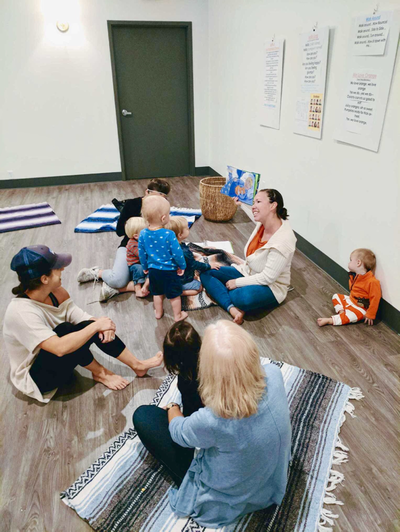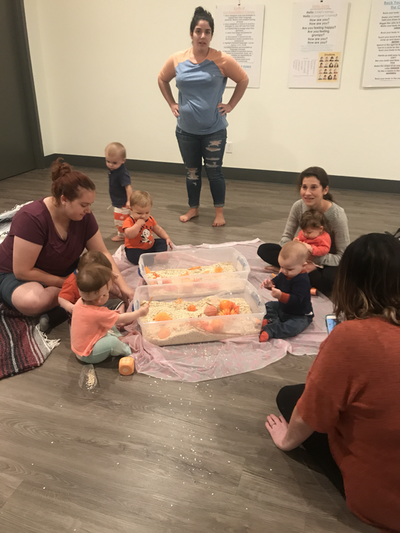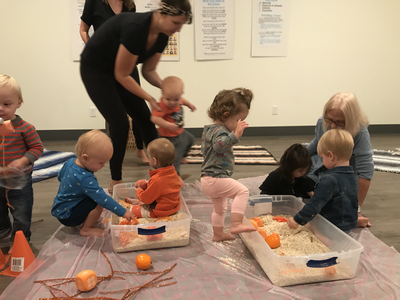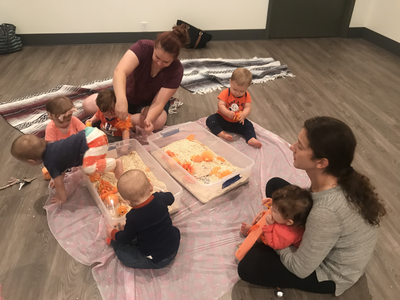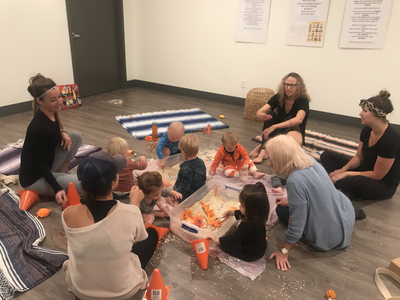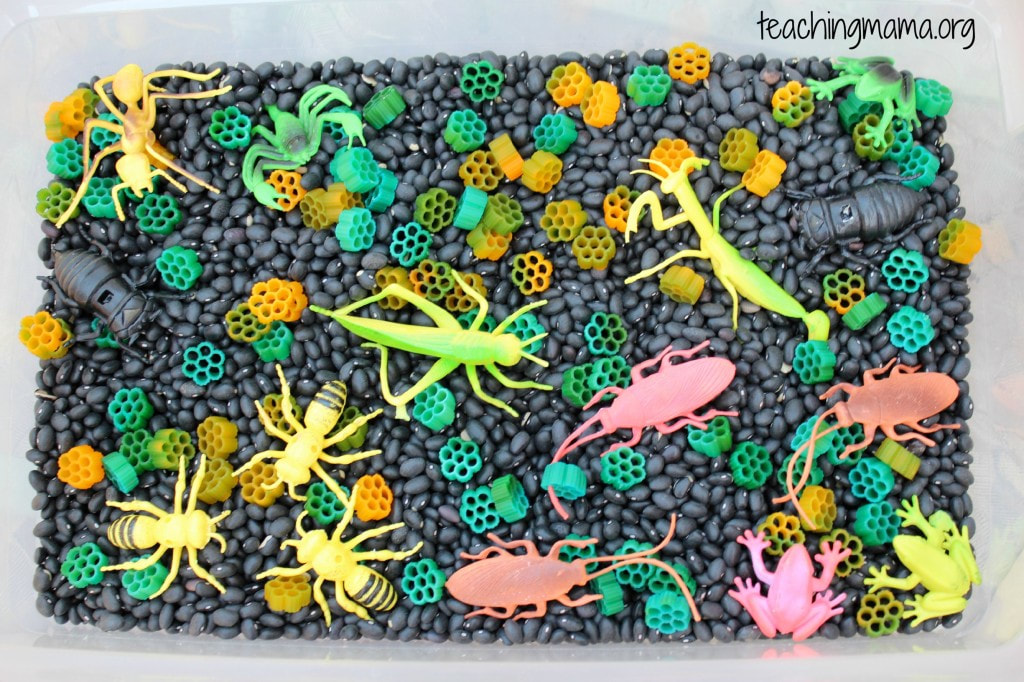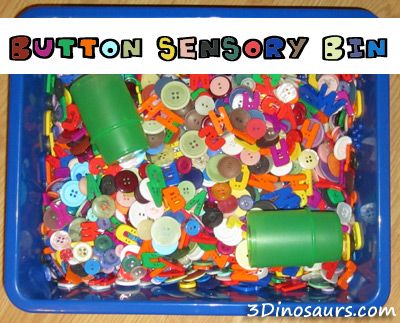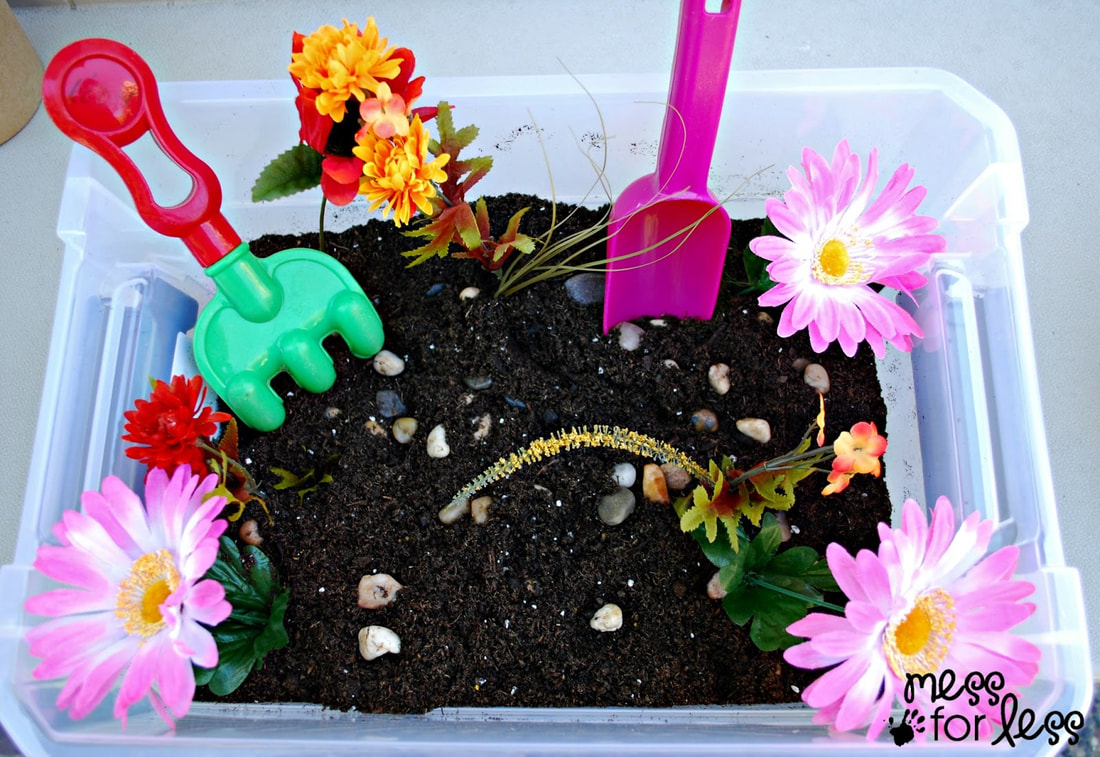Fun foundations class: orange
ORANGE!
In this research study, a group of researchers targeted color learning in children 2-5 years old. The intervention involved phrasing sentences so that the object came first in the sentence, then the color. For instance: "The ball is red" rather than "the red ball" OR "the cat is gray" rather than "the gray cat." They found that the children who heard the colors discussed in this manner all improved in their ability to learn colors!
- I like to target specific colors that are very noticeable in our environment at that time
- Obviously around this time of year, we see ORANGE everywhere! Between Halloween decorations, pumpkins and fall colors, it's all around us. It gives us a lot of opportunity to talk about the color.
- Color learning is NOT just a language skill – it is a huge perception skill as well, and it takes time and age for the ability to perceive and categorize different colors to emerge
- Additionally, children have to learn the skill of categorization in order to begin understanding the language concepts involved with color
- Did you know? Some cultures have 2 color categories, others have 20!
- Your child's ability to recognize different colors improves around 18 months, plus children begin to notice similarities and differences in shape, size, and texture around that age
- Around 2, children can sort items into categories - for example, toys into one basket and blankets into another
- At around 36 months, children can identify around 3 colors and name 1 color
- In the meantime, he'll add new colors to his repertoire through practice. Children love looking at picture books of objects organized by shape and color.
- Work on targeting nonverbal identification first.
- For example, ask him to show you a red square then let him point to it.
- Say, "I see a red flower,"
- If he's wearing a blue shirt, ask him if he sees anything else around him the same color.
- As he begins to learn the names of the colors, you can reverse the game, pointing to objects yourself and asking, "What color is this triangle?" Either way, he'll delight in showing off his knowledge.
- When he misses one, don't tell him he's wrong (or pretend he's right). Just say the correct name in an encouraging tone.
- Kids learn at their own speed, so don't be too concerned if your child doesn't know as many colors as someone else his age.
- Also, in my experience, 2 year olds often get red and green confused - not sure why!
In this research study, a group of researchers targeted color learning in children 2-5 years old. The intervention involved phrasing sentences so that the object came first in the sentence, then the color. For instance: "The ball is red" rather than "the red ball" OR "the cat is gray" rather than "the gray cat." They found that the children who heard the colors discussed in this manner all improved in their ability to learn colors!
skills + strategies discussed in class
The 1-Up Rule
Encourage comprehension and model phrases that your child will feel are approachable by using short and simple phrases only 1-2 words more than, or “1-up” from, what your child uses expressively.
Consider first: how many words does your child use at a time? Is he/she speaking in single words, combined words, or short sentences? If your child is currently only using single words, "1-up" them by speaking to them by using short 2- or 3-word phrases (e.g., if your child labels “car”, use phrases such as “fast car”, “blue car”, “go car!”, “more car?”). Not only does using a simple and shorter remark encourage comprehension, it also encourages imitation. A child is much more likely to attempt imitation of a short, two-word phrase than a long, five-word sentence!
Also, repeating words, phrases, and short sentences presents the child with multiple opportunities to hear, understand, and learn new words. While playing with your child, highlight a certain activity by repeatedly labeling it and exaggerating important words. For example, when rolling a car on a toy track, label by saying “fast car!” each time. When words or phrases are used repeatedly, they become familiar to the child. Add wait time to conversations with your child. Pause occasionally and wait for your child to take a turn speaking. It can be easy to dominate conversations when speaking with young children, but pausing can allow time to comprehend what has been said, as well as provide an opportunity to respond.
Just remember, the best way to increase your child’s language skills is by taking time to play, talk to, and interact with your child each day! Using these simple reminders can help make the most out of each teaching opportunity.
Narrating: Narrating (or broadcasting) is talking about what is happening while it is happening
Encourage comprehension and model phrases that your child will feel are approachable by using short and simple phrases only 1-2 words more than, or “1-up” from, what your child uses expressively.
Consider first: how many words does your child use at a time? Is he/she speaking in single words, combined words, or short sentences? If your child is currently only using single words, "1-up" them by speaking to them by using short 2- or 3-word phrases (e.g., if your child labels “car”, use phrases such as “fast car”, “blue car”, “go car!”, “more car?”). Not only does using a simple and shorter remark encourage comprehension, it also encourages imitation. A child is much more likely to attempt imitation of a short, two-word phrase than a long, five-word sentence!
Also, repeating words, phrases, and short sentences presents the child with multiple opportunities to hear, understand, and learn new words. While playing with your child, highlight a certain activity by repeatedly labeling it and exaggerating important words. For example, when rolling a car on a toy track, label by saying “fast car!” each time. When words or phrases are used repeatedly, they become familiar to the child. Add wait time to conversations with your child. Pause occasionally and wait for your child to take a turn speaking. It can be easy to dominate conversations when speaking with young children, but pausing can allow time to comprehend what has been said, as well as provide an opportunity to respond.
Just remember, the best way to increase your child’s language skills is by taking time to play, talk to, and interact with your child each day! Using these simple reminders can help make the most out of each teaching opportunity.
Narrating: Narrating (or broadcasting) is talking about what is happening while it is happening
- 2 types:
- Self-talk
- Parallel talk
- Self-Talk: use short sentences to talk about or describe what you are seeing, hearing or doing with your child - without expecting the child to respond.
- Examples:
- “I am making cookies! I am putting the chocolate chips in the batter! I am stirring. I am putting them in the oven.”
- “I’m sitting down at the table next to Carlos. I want to see what Carlos is doing with the play doh.”
- “Now I am writing a ‘W.’ I start here and go down, up, down, and up again. There---a ‘W’.”
- “I am digging in the sand with Monique. Deeper…deeper…deeper. Oh no---the sand is starting to cave in!”
- This skill comes naturally to some, but for some more quiet people it doesn’t - but practice makes perfect!
- Examples:
- Parallel Talk: use short sentences to talk about what your child is seeing, hearing or doing - like a broadcaster. You are watching the action and describing it to the child, without expecting a response. No questions during parallel talk.
- Examples:
- “Oh, you put the yellow block on top. Now you’re sliding the green one next to the long red block. The tower is getting taller.”
- “You are crawling toward the basket! You’re pulling the basket over!”
- “You’re holding a rattle! Shake shake! You are shaking the rattle!”
- If an infant is upset and crying after her mother leaves: "Sophie, you really hate to see your mom leave! You are feeling very sad. You wish that she could stay with you.”
- Examples:
- What narrating is NOT (don't skip this part!):
- Most importantly: do not use self talk and parallel talk to divert your child's attention away from what they are interested in. If your child is earnestly looking at a pinwheel, a sticker, or whatever is striking his fancy – talk about THAT. Do not break his focus by turning away his attention to something that you are doing or saying. We’ve all done this before, but we have to remember that toddlers learn best when we follow their lead and interests. Janet Lansbury, over at Elevating Child Care, has a fantastic post where she shares 7 Ways to Build Your Child’s Focus and Attention Span. It’s worth checking out.
- No questions
- I repeat: no questions. We ask a LOT of questions to children, often very rhetorical (your child is holding a ball and you ask, "is that a ball?" or "are you holding a ball?"), which often elicit only a yes/no answer at best.
- No expectation for child to imitate you
- Please do not have the expectation that your child is automatically going to repeat you. These techniques simply give your child exposure to language during play and daily routines. We’re using self-talk and parallel talk to expose the child to words and to make them realize that talking is fun AND functional. These techniques help to bridge the gap between a child who may not yet realize that objects, actions, and feelings, have names and they can be labeled and spoken about. If they imitate or repeat you, that’s wonderful, but it’s not expected at this point.
- Don’t do constantly – no need to overdo
- Think of it like a conversation – need to pause to allow your child a chance for turn taking and processing
- Even if your child isn’t taking a turn talking, he does need the chance to take a turn to listen and process what he is hearing
- Narrate 1-3 actions then stop, wait and OBSERVE
- Think of it like a conversation – need to pause to allow your child a chance for turn taking and processing
- Numerous studies have shown that a strong language base is key to academic success
- We have a very “language” based academic system (there are very few tests where you demonstrate knowledge by painting a picture, writing a song, etc.)
- The quantity of words spoken to a child in the first 3 years of life are associated with language skills, vocabulary size and IQ
- The words directly spoken to a child are responsible for vocabulary growth, not those passively heard like while watching TV or being around adults who talk to each other
- Another study showed toddlers 12-24 months benefit more from QUANTITY of words – children 24-36 months benefit from QUALITY of words (variety of more sophisticated words)
- When the goal is talking about something children are interested in, language growth occurs at a higher rate. Children as young as 18 months have higher vocabularies than peers if their parents talk about things they are interested in
- Narrating is intended to expose your child to meaningful language, not to generate a response from you
- We are providing a model of language
- One way to expose your child to lots of language is narration – especially with infants and toddlers
- Routines + play
- Diaper changes
- Getting dressed
- Cooking
- Meal time
- Bath time
- Outdoor play (park, backyard)
- Outings like the zoo or museum
- Play time
sensory activities
Why Sensory Activities?
(borrowed from Amanda Morgan at www.notjustcute.com)
Think of your average toddler or preschooler. How long has this child been proficient with language? Depending on the age, the child may not really be too proficient yet! Others seem to have been talking non-stop since 2 1/2, but that means they’ve been talking now for all of…..about a year! Now think of how long these children have been seeing, smelling, hearing, feeling, and tasting. Their whole lives! Children are wired to receive and utilize sensory input from day one. This is why children will dive in hands first, exploring a new substance. The senses are their most familiar, most basic way to explore, process, and come to understand new information.
This is why we must allow young children to learn through experience, not just lecture. These children need to use their senses and be engaged in meaningful experiences. As we talk with them about what they are observing and sensing, we give them new language tools to connect with these more familiar sensory tools, building language as well as supporting cognitive concepts specific to the experience.
Now, the flip side to this equation is important to remember as well. Just as children learn through their senses, they also are developing the ability to use those senses and are building the neurological pathways associated with each one. With added sensory experiences, combined with the scaffolding of adults and peers, children become more perceptive. Their sensory intake and processing becomes more acute. As they are better able to use their senses, they are then better able to learn through their senses.
Sensory play is really part of the scientific process. Whether out loud or within the internal dialogue of the mind, children have developed a question, leading them to investigate– by grabbing, smelling, listening, rubbing, staring, licking , what have you! They are using their senses to collect data and from that, attempt to answer their own questions. Whether or not young children are always able to verbally communicate this process, it is still a valid exercise in scientific inquiry.
The sensory table is the usually the first place people think of for sensory play. That’s logical, as the term “sensory” is shared by both. The sensory table certainly stands as an open invitation for hands-on exploration, but it is not the only place where the senses come into play. Throughout the preschool room and throughout the preschooler’s day, there are appeals being made to the five senses. The sound of toppling towers in the block area, the feel of finger-paint sliding under their fingertips, the glow of the Light Brite at the small manip table, the smell of cinnamon playdough. As teachers, the more we can attend to the sensory involvement of our planned activities, the more our children will be engaged and the more they will learn.
For example, when discussing the need for warm clothes in the winter time, we can simply tell children about it, or we can have them hold ice cubes, one in a bare hand, and one in a gloved hand, let them really feel the difference and then meaningfully attach a verbal discussion to the sensory experience.
(borrowed from Amanda Morgan at www.notjustcute.com)
Think of your average toddler or preschooler. How long has this child been proficient with language? Depending on the age, the child may not really be too proficient yet! Others seem to have been talking non-stop since 2 1/2, but that means they’ve been talking now for all of…..about a year! Now think of how long these children have been seeing, smelling, hearing, feeling, and tasting. Their whole lives! Children are wired to receive and utilize sensory input from day one. This is why children will dive in hands first, exploring a new substance. The senses are their most familiar, most basic way to explore, process, and come to understand new information.
This is why we must allow young children to learn through experience, not just lecture. These children need to use their senses and be engaged in meaningful experiences. As we talk with them about what they are observing and sensing, we give them new language tools to connect with these more familiar sensory tools, building language as well as supporting cognitive concepts specific to the experience.
Now, the flip side to this equation is important to remember as well. Just as children learn through their senses, they also are developing the ability to use those senses and are building the neurological pathways associated with each one. With added sensory experiences, combined with the scaffolding of adults and peers, children become more perceptive. Their sensory intake and processing becomes more acute. As they are better able to use their senses, they are then better able to learn through their senses.
Sensory play is really part of the scientific process. Whether out loud or within the internal dialogue of the mind, children have developed a question, leading them to investigate– by grabbing, smelling, listening, rubbing, staring, licking , what have you! They are using their senses to collect data and from that, attempt to answer their own questions. Whether or not young children are always able to verbally communicate this process, it is still a valid exercise in scientific inquiry.
The sensory table is the usually the first place people think of for sensory play. That’s logical, as the term “sensory” is shared by both. The sensory table certainly stands as an open invitation for hands-on exploration, but it is not the only place where the senses come into play. Throughout the preschool room and throughout the preschooler’s day, there are appeals being made to the five senses. The sound of toppling towers in the block area, the feel of finger-paint sliding under their fingertips, the glow of the Light Brite at the small manip table, the smell of cinnamon playdough. As teachers, the more we can attend to the sensory involvement of our planned activities, the more our children will be engaged and the more they will learn.
For example, when discussing the need for warm clothes in the winter time, we can simply tell children about it, or we can have them hold ice cubes, one in a bare hand, and one in a gloved hand, let them really feel the difference and then meaningfully attach a verbal discussion to the sensory experience.
|
Sensory Bins
(borrowed from www.loveplaylearn.com) Sensory bins are a great way for children to learn using all 5 senses at once. Child development theorist Jean Piaget described the way children learn by calling them “little scientists“. Through sensory play and sensory bins, children are using the scientific method and are also building pre-math skills, fine motor skills, language skills, imaginative play, and much much more. Not only that but sensory bins are so visually appealing and fun! Check out these 200 sensory bin ideas! To create a sensory bin you must first have a container to put you sensory materials in. I use one similar to this clear plastic container, that is a 6 pack and you only need one. You can also do a mini sensory bin. Next, you must decide on the theme of your bin and gather your supplies You don’t have to have a theme but making themed sensory bins can be a lot of fun. I love doing them for holidays. Most sensory bins have a base which is usually made with rice or another sensory material. Next you add other items including scooping materials such as spoons, measuring cups, etc for scooping and pouring. What do I put in a sensory bin? Here are a list of some possible bases:
Here are a list of some manipulative items:
For more great sensory bin ideas The Imagination Tree has wonderful sensory bins. Play Create Explore has a huge collection of beautiful and fun sensory bin ideas. Sensory Bin Tips 1.Be mindful of choking hazards. Sensory bins are supposed to be a closely supervised activity. Only put in what you are comfortable with your child handling. When I had a toddler I stick with things that are edible and that won’t be hazardous if ingested. 2. Take sensory bins outside or use a “mess mat” when indoors to contain the mess. I use a plastic shower curtain liner for the dollar store as my “mess mat” that I put under the sensory bin. 3.Be creative! Don’t worry, you can’t go wrong with a sensory bin. You can be as elaborate or as simple as you want to get and it will still be very beneficial for your child. 4. Get in on the fun Help your child get even more out of sensory bins by playing with them! Some sensory bins I enjoy playing with just as much as my child. They can be very relaxing to run your hands through! You can help them expand their knowledge while exploring. Talk with them and introduce new vocabulary words. 5.Store the materials in a large ziplock bag until you want to get it out to play again. Most of the materials can be stored for many months and used whenever you want. |
|
Sensory Bottles or "Calm-Down Jars"
I am by no means a Sensory Bottle expert, but this lady is! Check out this great post with tons of ideas for sensory bottles, plus there is more inspiration on her website for these bottles. Or, if you'd like to get lost in the world of sensory bottles, just search for "sensory bottle" or "calm down jar/bottle" on the web or on pinterest and prepare to lose about 3 hours of your life. ;) Christie, the Occupational Therapist over at www.MamaOT.com has an AWESOME post about the hows and whys of using a calm-down jar or bottle. Check it out! |
|
Toddler Pull Tubes
(borrowed this post at from www.diyanddinosaurs.com) This activity is so easy to make and I bet you have everything you need right at home.
Happy Crafting! |
signs taught in class
|
CAT
With both hands, pinch your thumb and index finger together by the side of each cheek, while keeping your remaining fingers straight out. As you pinch your fingers together take them from each side of your face outward. The sign looks just like you are teasing your whiskers straight. Now all you need is a smug smile. |
Songs from ORANGE class
LYRICS FOR "WE LOVE ORANGE"
(Tune: Three Blind Mice)
We love orange, we love orange.
Yes we do, yes we do!
Crunchy carrots so good to eat,
Juicy oranges, oh so sweet,
Pumpkins ready for trick-or-treat.
Yes, we love orange.
(Tune: Three Blind Mice)
We love orange, we love orange.
Yes we do, yes we do!
Crunchy carrots so good to eat,
Juicy oranges, oh so sweet,
Pumpkins ready for trick-or-treat.
Yes, we love orange.
LYRICS FOR "ORANGE IS THE COLOR"
(Tune: Yankee Doodle)
Orange is the color of so many things we see.
Would you like to sing a little Orange song with me?
Orange juice and orange cheese,
Orange Carrots, if you please.
Orange pumpkins, orange leaves,
Let's sing a song of Orange.
(Tune: Yankee Doodle)
Orange is the color of so many things we see.
Would you like to sing a little Orange song with me?
Orange juice and orange cheese,
Orange Carrots, if you please.
Orange pumpkins, orange leaves,
Let's sing a song of Orange.
LYRICS FOR "ORANGE ORANGE ORANGE"
(Tune: Three Blind Mice)
Orange, orange, orange.
Orange, orange, orange.
What is orange?
What is orange?
An orange, a cantaloupe, and a peach,
A pumpkin, a goldfish, and cheddar cheese,
The carrot that my little rabbit eats,
They are orange,
They are orange.
(Tune: Three Blind Mice)
Orange, orange, orange.
Orange, orange, orange.
What is orange?
What is orange?
An orange, a cantaloupe, and a peach,
A pumpkin, a goldfish, and cheddar cheese,
The carrot that my little rabbit eats,
They are orange,
They are orange.
|
|
LYRICS FOR "ROCK YOUR BODY TO THE COLORS"
Rock your body to the colors x2 Shake your head to the color RED Twist your shoes to the color BLUE Wiggle like Jello to the color YELLOW Make your body lean to the color GREEN Rock your body to the colors x2 Touch your back to the color BLACK Jump up and down to the color BROWN Stretch to the right for the color WHITE Turn in a circle for the color PURPLE Rock your body to the colors x2 Hands up and sway to the color GREY Use your brain and think to the color PINK Make the shape of an orange for the color ORANGE Fly like a manta to the color MAGENTA Rock your body to the colors x2 |
|
|
LYRICS FOR "WALK AROUND"
Walk around… Now Bounce! Walk around… Side to Side… Walk around… Turn around… Walk around… Now sit down with me |
BOokS FOR TALKING ABOUT orange
|
The book we read in class was Where is Tippy Toes? by Betsy Lewin. This book is about a mischievous orange cat that tippy-toes through all sorts of things. The pages are die-cut for little peek-a-boo windows. Very cute!
|
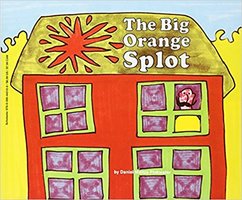
The Big Orange Splot by D. Manus Pinkwater: The main character lives on a "neat street" where all the houses look the same. One day, a seagull flies over his house and drops a can of bright orange paint on his roof, but instead of repainting his house to look like all the others on the street, Mr. Plumbean paints it to resemble his dreams. His neighbors send people to talk him into repainting his house to look like theirs, but everyone he talks to ends up painting their houses like their dreams also. In the end, all the neighbors say:
"Our street is us and we are it. Our street is where we like to be, and it looks like all our dreams."
This book is celebrated with its message of nonconformity, individualism and creativity.
"Our street is us and we are it. Our street is where we like to be, and it looks like all our dreams."
This book is celebrated with its message of nonconformity, individualism and creativity.
|
Color Me Orange by Nancy McLoughlin: Owen Orange discovers that he's disliked by the owner of his crayon box, so he is never selected to help make beautiful pictures. Because he is relegated to life lived only in his crayon box house, he is unable to join in on the fun coloring activities going on in the classroom. Even though his color friends describe the classroom, the lovely pictures, the teacher, and the children for him, it's just not the same as seeing them for himself. One day, though, he meets Madeline, and he discovers that he is just as special as all the other crayons in his box.
|
|
Orange Pear Apple Bear by Emily Gravett: We read this in our APPLES class, but works great for ORANGE also! It contains only five words: apple, pear, orange, bear--and there. Emily Gravett creates clever variations on this theme by rearranging the words--on one spread, a brown bear juggles an orange, apple, and pear; on another spread, there is an orange-colored apple and a pear-shaped bear. Simple and compelling, children will enjoy reading this book over and over again as they learn many different concepts.
|
|
It's an Orange Aardvark! by Michael Hall: Acclaimed New York Times-bestselling picture book creator Michael Hall delivers a funny and suspenseful story about colors, ants, aardvarks, and rainbows.
|











